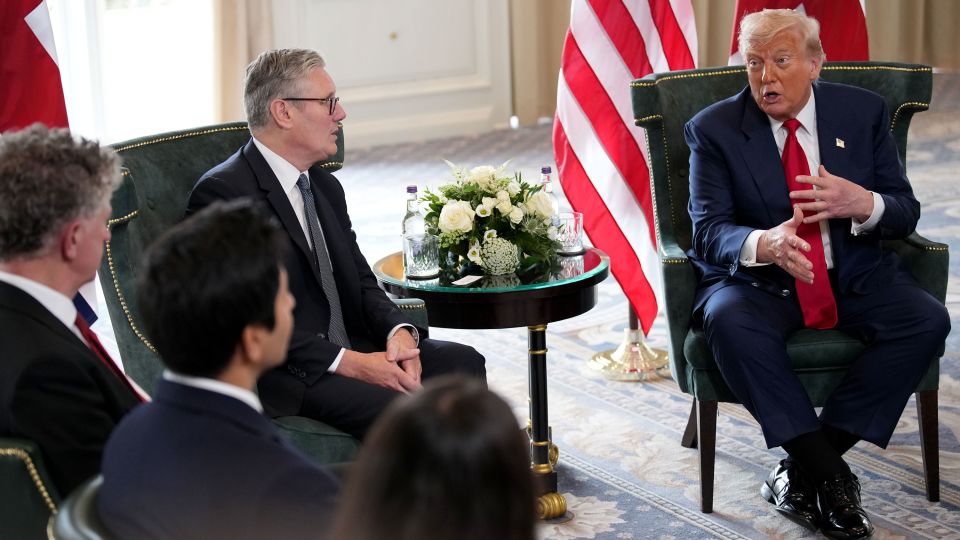President Donald Trump made big news Monday, shortening his 50-day deadline for Russia to get serious about peace in Ukraine to “about 10 to 12 days from now.”
“There’s no reason in waiting,” Trump said. “I want to be generous, but we just don’t see any progress being made.”
Trump has said that Russia failing to meet this deadline would result in strong tariffs and secondary sanctions, going after countries that purchase Russian oil.
What this means, practically speaking, is that Russia now has until about August 9 – instead of early September – to reach a ceasefire deal with Ukraine before those severe measures could kick in. The Senate appears poised to pass a serious set of sanctions that has the support of more than 80 lawmakers, whenever the president gives the go-ahead.
But that’s if he actually sticks to his new deadline.
Plenty of analysts have noted that Trump’s deadlines are often malleable. He regularly promises something in “two weeks” and then doesn’t produce it. His tariffs deadlines have regularly moved back when trade deals were not struck.
But in perhaps no arena are these deadlines more significant than in foreign policy with adversaries. And repeatedly this year, Trump has proven even those deadlines aren’t particularly hard.
That’s especially the case on the subject of Russia, where Trump has given himself a series of “two weeks” deadlines, and then let those deadlines pass – before going to 50 days and now 10-12 days.
When pressed last month on those missed two-week deadlines, White House press secretary Karoline Leavitt emphasized that these are “complicated global conflicts” that Trump is trying to resolve.
But the president is also someone who has, at least in the past, emphasized the folly of setting hard lines with adversaries and not following through. He repeatedly criticized then-President Barack Obama for setting a “red line” with Syria on using chemical weapons and then not acting when it did.
Trump said in his 2016 Republican National Convention speech that “the whole world knew it meant absolutely nothing.”
So how have Trump’s deadlines panned out early in his second term? Let’s examine.
The Iran deadlines
Mid March: Trump sends a letter to Iran’s Supreme Leader Ayatollah Ali Khamenei giving him two months to reach a nuclear deal.
Apparent deadline: Mid May
June 13: Trump gives Iran a “perhaps, a second chance.” He suggests the earlier two-month deadline was actually June 12, and it has passed: “Today is day 61. I told them what to do, but they just couldn’t get there,” he posts on Truth Social.
June 19: Trump suggests he will make a decision on striking Iran soon. “I will make my decision whether or not to go [strike Iran] within the next two weeks,” Trump said in a statement read by White House press secretary Karoline Leavitt.
Apparent deadline: July 3
June 21: Trump launches strikes on Iran’s nuclear facilities, just two days after saying his decision could take two weeks.
His initial two-month deadline clearly passed. Republicans have suggested the strikes Trump ultimately launched showed his threat was a real one. But it’s not clear how much of this was happenstance – Israel seemed to open the door by launching its own strikes on Iran in mid-June – and how much of it was planned out in advance.
And his decision to launch the strikes so soon after saying he’d decide within two weeks has led some to suspect that was a ruse. Indeed, CNN has reported that allies who spoke with him on June 19 say it was clear the decision to strike had already been made – though it was always subject to a reversal.
The Russia-Ukraine war’s many deadlines: Two weeks, 50 days and now 10-12 days
April 24: Trump says of making decisions on continuing military assistance to Ukraine: “You can ask that question in two weeks, and we’ll see, but I think we’re getting very close.”
April 27: When asked if he trusts Russian President Vladimir Putin, Trump says: “We’ll let you know in about two weeks.”
Apparent deadline: May 8
May 14: When a reporter asks whether Putin is “tapping him along,” Trump says: “I’ll let you know in a week. I’ll let you know in a few days.”
Apparent deadline: May 21
May 19: Trump gives himself another two weeks to determine whether Ukraine is serious about ending the war: “I’d rather tell you in about two weeks from now because I can’t say yes or no.”
Apparent deadline: June 2
May 28: “I’ll let you know in about two weeks, within two weeks,” Trump says when asked if Russia is serious about ending the war. He adds: “We’re going to find out whether or not [Putin is] tapping us along or not. And if he is, we’ll respond a little bit differently.”
Apparent deadline: June 11
But rather than meet that deadline, Trump has recently extended it – and now shortened that extended deadline – while suggesting a tougher response if Russia doesn’t play ball.
July 14: “We’re going to be doing very severe tariffs if we don’t have a deal in 50 days,” Trump says. “Tariffs at about 100%, you’d call them secondary tariffs. You know what that means.”
Apparent deadline: Sept. 2
July 28: Trump says the deadline is now 10 to 12 days due to a lack of progress. “Yeah, I’m going to make a new deadline of about 10 or 12 days from today,” he says, adding: “Because I think I already know the answer.”
Apparent deadline: Aug. 9
Trump’s deadlines have been all over the place. Many of them deal with different aspects of negotiating an end to the war in Ukraine. But he’s rarely provided the hard verdicts on key issues that were promised on a specific date.
TikTok’s many extensions – and fleeting promises of progress
Jan. 20: Trump signs an executive order delaying for 75 days enforcement of a congressionally passed law forcing TikTok to divest from its Chinese owners or be blocked domestically. He says he will use the time to cut a deal to sell TikTok. (Despite the 75-day window, Trump casts it as “90 days to make that decision.”)
Deadline: April 5
April 3: “We’re very close to a deal with a very good group of people for TikTok,” Trump says.
April 4: Trump signs another 75-day extension, saying a deal required “more work to ensure all necessary approvals are signed.” He would later say a “report” that China pulled back “changed the deal because of tariffs.”
Deadline: June 19
April 17: Trump suggests a deal could be imminent, and suggests he’ll just keep extending deadlines as needed. “We have a deal for TikTok, but it will be subject to China,” Trump says. “So, we’ll just delay the deal until this thing works out one way or the other.”
June 19: Trump signs another extension, this time for 90 days. Leavitt says extra time is needed and that Trump “does not want TikTok to go dark.”
Deadline: Sept. 17
June 29: Trump claims in an interview airing that day: “We have a buyer for TikTok.” Asked who it is, he says, “I will tell you in about two weeks.”
Apparent deadline for naming TikTok buyer: July 13
July 4: “We pretty much have a deal,” Trump tells reporters, signaling that talks with China would begin a few days later.
Three weeks later, there is still no deal, and he hasn’t said who the supposed buyer is.
Trump, who said he would ban TikTok during his first term, has now made it abundantly clear that he doesn’t want to shut down TikTok, because people like it and it’s good for him politically. That could certainly put less pressure on the Chinese to cut a deal.
For more CNN news and newsletters create an account at CNN.com

